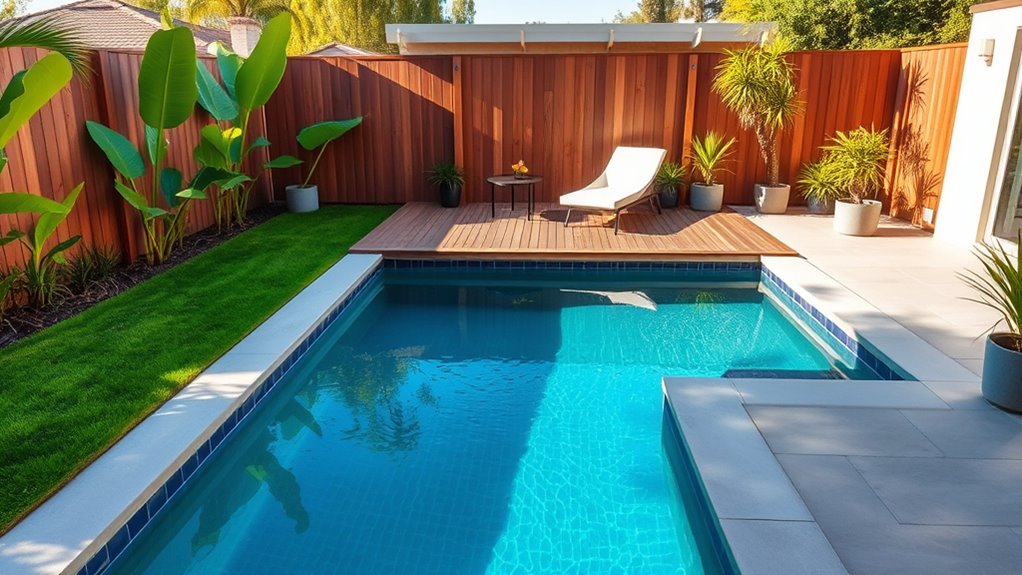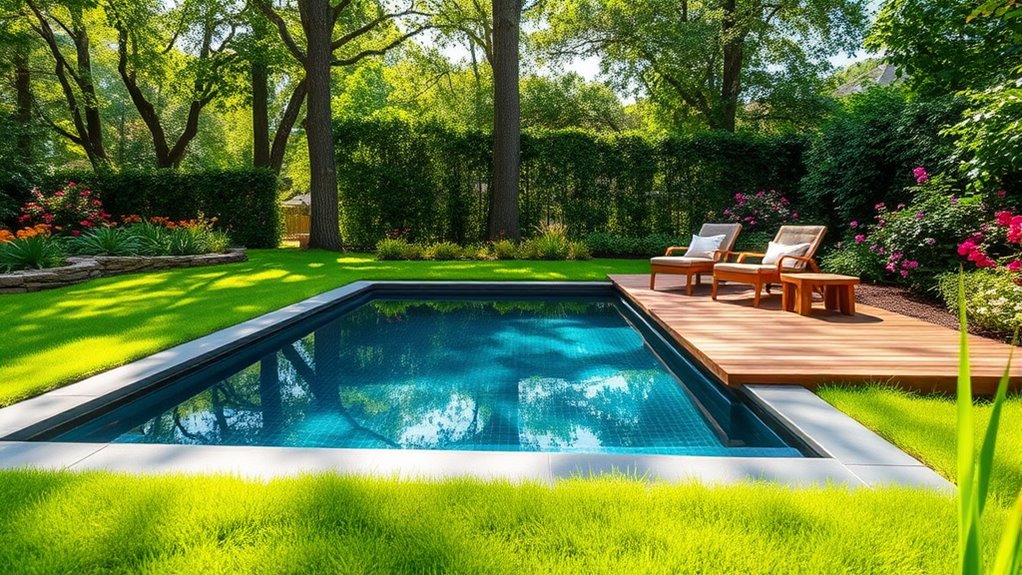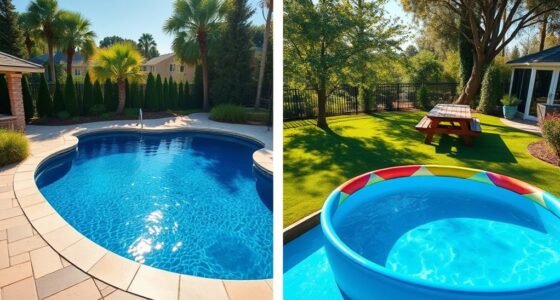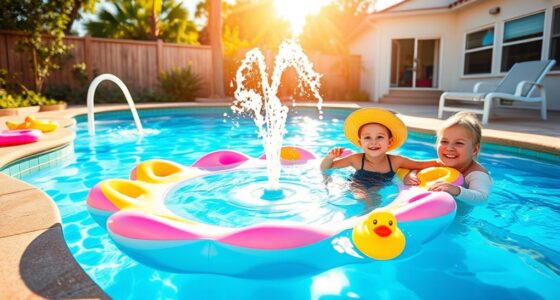Plunge pools are quickly becoming a popular choice for small backyards because they maximize space while offering a stylish, relaxing feature. They’re affordable, easy to maintain, and perfect for quick dips on hot days. With options in various shapes and sizes, you can easily fit one into your outdoor space. Plus, their low water volume means less cleaning and lower costs. Want to discover how you can transform your backyard with a plunge pool? Keep exploring!
Key Takeaways
- Plunge pools are compact, stylish options ideal for small outdoor spaces, providing luxury and relaxation.
- They are easier and cheaper to maintain due to their smaller water volume.
- The trend enhances backyard aesthetics and maximizes limited space efficiently.
- Installation costs are lower, making plunge pools a cost-effective outdoor upgrade.
- Proper design and placement ensure they boost outdoor enjoyment and overall backyard appeal.

Have you ever considered adding a plunge pool to your backyard? These small, stylish pools are quickly becoming a popular choice for homeowners looking to maximize outdoor space while still enjoying the benefits of a refreshing dip. While they may be compact, plunge pools pack a punch when it comes to convenience and luxury. But before you immerse yourself, it’s important to think about the practical aspects, like pool maintenance and cost considerations. Knowing what’s involved will help you make an informed decision and guarantee your new feature remains a joy rather than a chore.
Considering a plunge pool? Small yet stylish, they offer luxury and convenience with simple maintenance and cost benefits.
When it comes to pool maintenance, plunge pools tend to be easier to care for than larger pools. Their smaller size means less water to treat and filter, which can considerably cut down on cleaning time and chemicals. Still, routine upkeep is essential to keep the water clear and safe. You’ll want to invest in a good filtration system and regularly check chlorine levels, pH balance, and water temperature. Covering your plunge pool when not in use can reduce debris accumulation and evaporation, making maintenance even simpler. Keep in mind that neglecting maintenance can lead to algae growth or equipment failure, so staying consistent is key. Fortunately, many modern plunge pools come with automated cleaning features or smart technology, which can help streamline upkeep and minimize your effort.
Cost considerations are another important factor. The initial purchase price of a plunge pool is generally lower than a full-sized pool, but it’s not just about the upfront investment. You’ll need to budget for installation costs, which include site preparation, electrical work, and possibly permits. Ongoing expenses include chemicals, filter replacements, and routine maintenance, all of which are less costly than maintaining a larger pool. Additionally, energy costs can be lower because smaller pumps and heating systems are more efficient. However, don’t forget to factor in potential landscaping or decking expenses to create an attractive surrounding area. If you’re considering heating the pool for year-round use, that will add to your costs but can extend your enjoyment through colder months. Overall, plunge pools can offer a cost-effective way to enjoy a private oasis without breaking the bank, especially if you plan carefully and keep up with maintenance.
In addition, selecting the right size and shape can optimize your backyard space and increase your enjoyment. Whether you prefer a compact square design or a more organic shape, proper planning ensures your plunge pool complements your outdoor environment.
In the end, whether you’re looking for a quick cool-down or a stylish backyard feature, plunge pools are a smart choice. They’re easy to maintain and generally affordable, making them accessible for many homeowners. Just be sure to weigh the initial costs against ongoing expenses and maintenance needs. With proper planning, your plunge pool can be a delightful addition that enhances your outdoor living space and provides countless relaxing moments.
Frequently Asked Questions
How Much Does a Plunge Pool Typically Cost to Install?
A plunge pool typically costs between $10,000 and $20,000 to install, depending on size and features. You’ll want to think about costs for pool heating and water filtration systems, which can add to the overall price. Installation may involve site prep and permits, so budget accordingly. Keep in mind that regular maintenance, like water filtration, keeps your pool clean and enjoyable, making the investment worthwhile.
What Are the Maintenance Requirements for a Plunge Pool?
Think of your plunge pool as a small oasis that needs regular care. You’ll need to handle chemical maintenance, balancing pH and chlorine levels to keep the water clean. Seasonal upkeep involves cleaning filters, inspecting for wear, and covering it during colder months. While it’s less demanding than larger pools, consistent attention ensures your plunge pool stays inviting and safe, providing invigorating escapes without overwhelming your schedule.
Can Plunge Pools Be Installed Indoors or Only Outdoors?
You can install plunge pools both indoors and outdoors, depending on your space and preferences. Indoor installation is possible if you have a suitable area with proper ventilation and waterproofing, but outdoor suitability is more common because it’s easier to accommodate the pool’s drainage and ventilation needs. Consider your available space, climate, and maintenance requirements to decide whether an indoor or outdoor plunge pool works best for you.
Are Plunge Pools Energy-Efficient Compared to Traditional Pools?
You might wonder if plunge pools are energy-efficient compared to traditional pools. Generally, they use less water and require less energy for heating and filtration, leading to better energy savings. Plus, if you choose eco-friendly materials for construction, you can reduce your environmental impact further. Overall, plunge pools are a smart, eco-conscious option that helps you enjoy your backyard while minimizing energy use and promoting sustainability.
How Long Does It Take to Install a Plunge Pool?
You can typically install a plunge pool in about 1 to 3 weeks, depending on your site and design. During installation, guarantee pool safety by properly installing fencing and covers, and set up water filtration systems to keep the water clean. If you opt for professional help, they’ll manage the groundwork and plumbing efficiently, making the process smoother and ensuring your new plunge pool is safe and ready for use quickly.
Conclusion
Ready to transform your backyard into a relaxing oasis? Plunge pools are the perfect way to make a big splash without taking up much space. They offer convenience, style, and an invigorating escape right at your doorstep. So, why not embrace this tiny trend and enjoy your own personal retreat? After all, isn’t creating a sanctuary where you can unwind worth a little splash? Your perfect backyard escape could be just a plunge away.










